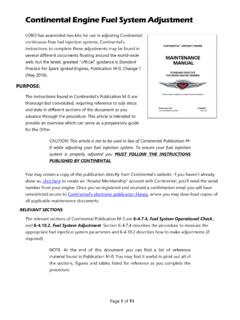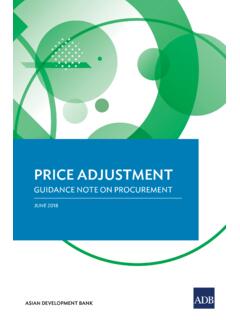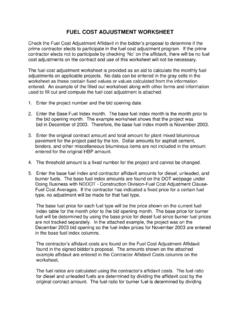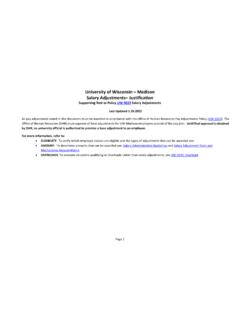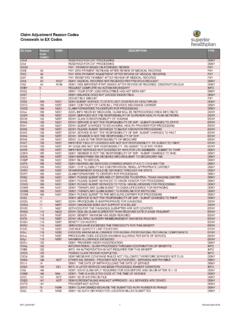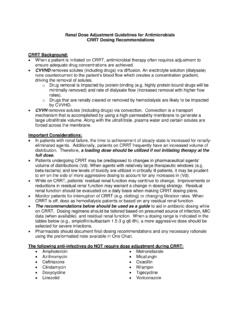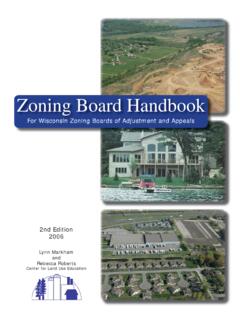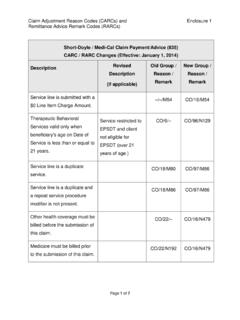Transcription of Psychological First Aid - Australian Red Cross
1 Psychological First Aid:Supporting people affected by disaster in Australia Australian Red CrossThird edition published by: Australian Red Cross 2020 155 Pelham St, Carlton, Victoria 3053andAustralian Psychological Society Level 11, 257 Collins St, Melbourne, Victoria 3000 Photography copyright: All images are referenced within and remain the property of the Australian Red Cross , stated photographer, or other parties as this resource, the term emergency is used and can apply to any form of emergency incident or disaster. Where the term disaster is used, this is interchangeable to emergency and connotations of one term over the other should not be rights reserved. No part of this publication may be reproduced, stored in a retrieval system, or transmitted in any form, or by any means, electronic, mechanical, photocopying, recording or otherwise without the prior written consent of the image: Australian Red CrossPsychological First Aid:Supporting people affected by disaster in Australia32 ContentsForeword 4 Psychosocial reactions to crisis situations 8 Common reactions 10 Complex reactions 12 Understanding Psychological First aid 14 What is Psychological First aid?
2 15 What Psychological First aid isn t 16 The aim of Psychological First aid 17 Five elements of psychosocial support 18 Providing Psychological First aid 22 Who benefits from Psychological First aid? 23 Who delivers Psychological First aid? 24 Where is Psychological First aid given? 25 When do you provide Psychological First aid? 25 Psychological First aid action principles 26 Preparing to provide Psychological First aid in the field 28 Psychological First aid for children 30 Additional guidance for supporting children 32 Psychological First aid for people with physical or mental health conditions or intellectual disabilities 34 Self care for people working in the field 38 Reducing stress 39 Look, Listen, Link for self care 40 Supporting your colleagues 41 Useful organisations 42 References and resources 44 Acknowledgments 48 End Notes 50 Fundamental Principles 5254 ForewordThis Psychological First aid guide is for people working in disaster preparedness, response and recovery.
3 It provides an overview of best practice approaches to Psychological First aid following disasters and traumatic Australia, each state and territory has plans to deal with the health impacts of disasters. Included in these plans are arrangements that cover the mental health impacts of emergencies. This guide sets out to simply outline how Psychological First aid can be operationalised in Australia. The guide is also used in conjunction with Psychological First aid training delivered by Australian Red is the generic term used in Australia to describe disruptive and/or destructive events that cause loss of life, property and livelihoods, injury and damage to communities. For the individual this may mean the loss of: Loved ones or significant others Control over one s own life and future Hope and initiative Dignity Social infrastructure and institutions Access to services Property and belongings Livelihoods The natural environment, important cultural sites and other places of an emergency, people can lose confidence in the norms, networks, and trust in the society that is supposed to protect Until the late 1970s, the psychosocial aspect of emergencies was often ignored.
4 Emergency management activities focused more on the rebuilding of towns damaged by floods, fire or storms and healing the physical wounds of those mental health and the identification of post-traumatic stress disorder led to a shift in approaches to emergency management. Responses during this period focused on applying clinical mental health skills in emergency settings, for which they were never was then recognised that most people did not develop serious mental health issues after emergencies. Most people recover well with some basic support. This led to the development of Psychological First aid as a primary tool for supporting people after an has been recognised both in Australia and internationally that psychosocial support in emergencies is best delivered as a community-based Providing coordinated psychosocial support in emergencies has now become a critical part of preparing for, responding to and recovering from an guide is in line with the following resources: A Guide to Psychological First Aid (International Federation of Red Cross Red Crescent Societies, 2018) and Psychological First aid: Guide for field workers (World Health Organization, War Trauma Foundation and World Vision International, 2011).
5 45 Australian Red Cross 7698 People may experience strong emotional and physical distress reactions when faced with situations that result in death, or serious injury to themselves or others. Feelings of intense fear and thinking one may die or be seriously injured can also cause intense feelings of distress. These situations can be either directly experienced or witnessed. The loss of treasured belongings, community icons and connections to place also can cause psychosocial are many different situations that may cause people to experience suffering and reactions to crisis situationsThese may include situations such as: Personal crises Social challenges Health challenges Disasters caused by natural hazards Human caused disasters Violence Armed conflict Forced crisis situations, such as disasters, armed conflict and forced migration have far-reaching and varied impacts on people and the communities they belong to, geographic or otherwise.
6 The impacts of disasters affect all aspects of wellbeing, degrade quality of life and undermine the social connectivity of :5 People do not all react at the same time or in the same way to a crisis Not everyone needs or wants support Witnesses to a frightening event may also be strongly affected and need support Some people are calm and do not react strongly at the time of an event, but have strong reactions later Some people have strong reactions, and can manage their situation on their own, or have support from other is a state of pressure or strain that takes place in many different situations. It can be caused by any change positive or negative. Stress is an ordinary part of everyday life. It is positive when it makes a person perform well, for example, in a test or exam.
7 However, stress can also be negative and lead to distress and is when someone is unable to cope with or adapt to the challenges or situation they are facing. Distress leads to physical and emotional discomfort and suffering. It can be caused by a one-off crisis event or from stress building up over reactionsHow people react to difficult experiences depends on the nature of the experience, their resilience, their age and personality, their support system and usual coping methods, how much time has passed since the time of the event, and previous , there are some common emotional and physical distress reactions that can be expected immediately during and in the days, weeks, months or years after a crisis These include, but are not limited to: Feelings of guilt, sadness, relief, anger, fear, anxiety, confusion, uncertainty, hopelessness Feeling numb, increased heartbeat, sweating, shaking, trembling or shortness of breath Difficulty making decisions and comprehending complex information Difficulty communicating clearly with others Feelings of helplessness or powerlessness Feeling Red Cross 1312 Prolonged grief is when someone finds it hard to accept and adapt to the loss of someone they loved.
8 The grief then affects how the person lives from day to day and how they relate to other people. It is not an immediate reaction. It develops over a period of time. It can also lead to extreme feelings of distress when the person experiences new challenges or is somehow reminded of their problems are very common after crises. Many people find it difficult to fall asleep or experience nightmares. Some people sleep more than usual and find it hard to wake up. If sleeping problems go on for many days and nights, it can lead to physical and Psychological problems. Severe sleeping problems interfere with daily living, moods and relationships with other people, and seeking support can be are when a person feels as if they are back in the moment of the original stressful event.
9 Flashbacks often feel real and can be confusing and frightening. They can be a normal reaction to abnormal experiences. However, the person may still need help to manage factors can increase the risk of developing complex reactions. For example if the person: Was separated from their family Thought they were going to die Was involved in a situation where the horror element was high Has had previous traumatic experiences Lost loved ones Has an underlying Psychological of anxiety and anger are common reactions to crisis. However, some people may experience intense or prolonged feelings that do not resolve as expected. These people may benefit from more specialised reactions8 Complex reactions are more serious than common reactions to distress. A person with complex reactions often needs referral for specialised help or other of complex reactions are:Panic attacks and feelings of overwhelming anxiety can produce a faster heartbeat, shortness of breath, and pain in the chest.
10 A person may sweat more than normal, feel dizzy or light-headed and feel like they want to be and aggressive behaviour are familiar reactions to crisis in situations of violence, or when people have experienced immense and suicide. Self-harm is when a person hurts himself or herself on purpose, for example, by cutting or burning their skin and flesh. Suicide is when someone intentionally takes his or her own life. It is important to always take someone who threatens to harm or kill themselves seriously and not leave the person alone until more help coping methods include self-medicating with drugs or alcohol, becoming violent or aggressive, withdrawing or keeping oneself completely apart from other Psychological First aidWhat is Psychological First aid? Psychological First aid is a psychosocial support activity that helps people affected by an emergency, disaster or traumatic event.
